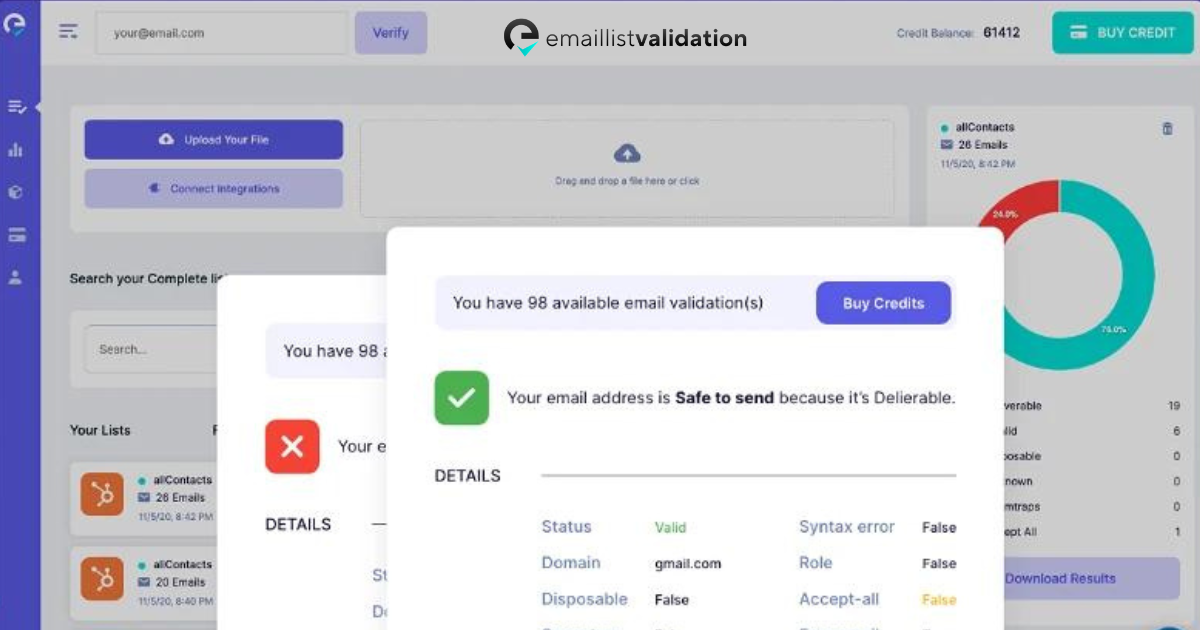Email Bounce Rate: Ultimate A-to-Z Guide
These days, most of us take email for granted. We write them, hit the send button, and just walk away. However, sometimes something gets wrong, and you get that ugly bounce email in your inbox.
If you are emailing a friend, then this is not such a big problem. However, if the emails you are sending are part of a marketing campaign, your job or the success of your business may depend on your emails reaching the contact list.
If you are regularly sending mass emails, you are likely familiar with this situation. Even though email bounce back is consistent in the world of email marketing, it is not something that you are stuck with forever.
With a little insight and a few good strategies, you can cut down your email bounce rate significantly and in this post, we will show you exactly that. From the basics to the more advanced strategies — we got it all covered.

What is an email bounce?
An email bounce is an email that cannot be delivered to the recipient. Due to many reasons, email servers may reject the emails you sent. When the server bounces the email back to you, it also sends a code that can be helpful for understanding why the email was rejected.
The process of email bounce back
This happens almost at the end of the email delivery process which consists of the following steps:
- You write the email and fill out the ‘To’ field. If you are sending a mass email for a marketing campaign, this most likely happens automatically.
- When you hit the send button, your email transfer protocol server queues it up for delivery.
- The SMTP server looks at the server it should be sending the email to and it checks the domain name server for the IP address of that server.
- Using an email transfer agent, the SMTP server sends the email to the recipient’s server.
- If the email is successfully delivered, the recipient server displays it in the recipient’s inbox. If the email fails to deliver, the server bounces the email back to you with an error code, like we already mentioned.
Types Of Email Bounces
All email bounces can be divided into two categories: hard and soft. Some email services name hard bounces as permanent failures. On the other side, temporary failure is a soft bounce.
Hard email bounce
A hard bounce is a permanent failure. The server was unable to deliver the email and has stopped trying to send the message. If you see the 550 error code, it means that you have a hard bounce.
The most common reasons why an email hard bounces include: unknown user or domain errors, emails that are blocked by the server either due to spam or policy filters. Other reasons include the misconfiguration of the recipient’s email servers or too-large or invalid file types in the attachment.
Soft email bounce
A soft bounce is usually a temporary failure in delivery. Email servers use code 421 for soft failures, and most of them do not send notices about soft failures.
There is nothing for you to do when an email has a soft bounce, as the email server will retry to send your message. If the message cannot be delivered after multiple attempts, the soft bounce will become a hard bounce for which you will be notified by your server.
The most common reasons for a soft bounce include temporary issues with the network or the recipient’s server. Other reasons could be that the recipient’s inbox being full or them using greylisting, a type of spam filter that purposefully disables email to try and fight of spam email, as many spambots do not retry any failed emails.
Why Should You Care About Your Email Bounce Rate?
You may think that the email bounce rate is not that big of a deal. At the end of the day, you may think that you should be more interested in when your emails get opened rather than when it bounces. However, the email bounce rate is very important, as it has a huge impact on the deliverability and reputation of all your future emails.

If you have a high email bounce rate, it is more likely that your emails will be blacklisted by recipient servers which increases your email bounce rate even more. Also, your emails are more likely to be marked as spam if you have a bad reputation due to your poor email bounce rate.
If you work on your email bounce rate, you will be more thoughtful about who you are emailing, and chances are that by cleaning up your email list, you will improve your open rate.
Strategies For Reducing Email Bounce Rate You Should Try
Even though it may sound that you cannot do anything about your email bounce rate, there are still some ways you can try and reduce them.
Clean up your email list
The best way to reduce your email bounce rate is to clean up your mailing list and ensure that it stays clean. Having a cleaned out and up-to-date mailing list will also help you home in on the contact information of all your leads that are truly interested in the products or services you are offering.
Instead of trying to sell to all your leads, with a cleaned-up email list, you will more easily focus on selling to only those prospects that are really interested.
Always ask for permission
Another way to reduce your email bounce rate is to generate your mailing lists from a form that also asks for permission to receive messages. While it may sound tempting to build a huge email list, by asking people to opt-in to receive your messaging, you are narrowing down your list of people who want to hear what you have to say.
If you send content to people that are not interested will likely negatively affect your email bounce rate. Plus, sending emails without explicit permission is illegal in some parts of the world such as the European Union.
The double opt-in email process
You should also consider having a double opt-in email process. A double opt-in email process is when you verify that you have the correct email by sending over another email with a subscription link.
Send regular emails
To improve your email bounce rate, you should also send regular emails. Obviously, you should not just send emails for the sake of sending them. However, by regularly providing value to your email recipients, you can have many benefits including a reduced email bounce rate, increased email engagement, and avoiding spam filters.
Write professional emails
Also, another way to reduce your email bounce rate is to avoid sound like a spammer. To do this, make sure that all your emails are well-written and looking professional. Also, never send emails that have spammy subject lines, and never hide any content or links in your email’s HTML code.
Use an email verification service
If you want to reduce your email bounce rate and ensure that your emails get delivered to the right inbox, you should consider using software such as Email List Validation.

Email List Validation is a software that can help protect your email marketing campaigns from hard bounces, spam traps, and fake emails by verifying and cleaning up your email list. With Email List Validation, you can also verify the deliverability of any email address before it lands a spot in your database.
If you want to reduce your email bounce rate and ensure that your emails get delivered to the right inbox, you should consider using software such as Email List Validation.
Email List Validation is a software that can help protect your email marketing campaigns from hard bounces, spam traps, and fake emails by verifying and cleaning up your email list. With Email List Validation, you can also verify the deliverability of any email address before it lands a spot in your database.
You can also fight database decay and automatically remove any bad emails, thus reducing your email bounce rate and ensuring that your emails land in the recipient’s inbox more times.
Final Thoughts
So there you have it, the ultimate email bounce rate A-to-Z guide. We hope that this guide has shown you the importance of email bounce rate in today’s business, no matter your industry or what you offer to your customers, as it affects all businesses.
If you are sending any type of mass email in your business, ensuring that your email bounce rate is low should be on top of your priorities. The process of reducing your email bounce rate starts even before you send any email and if it is done right, it can provide huge benefits to your business in 2020.
On the contrary, having a huge email bounce rate can negatively affect your business and the consequences can even be permanent. That is why we feel that having a low email bounce rate is important in today’s world.



